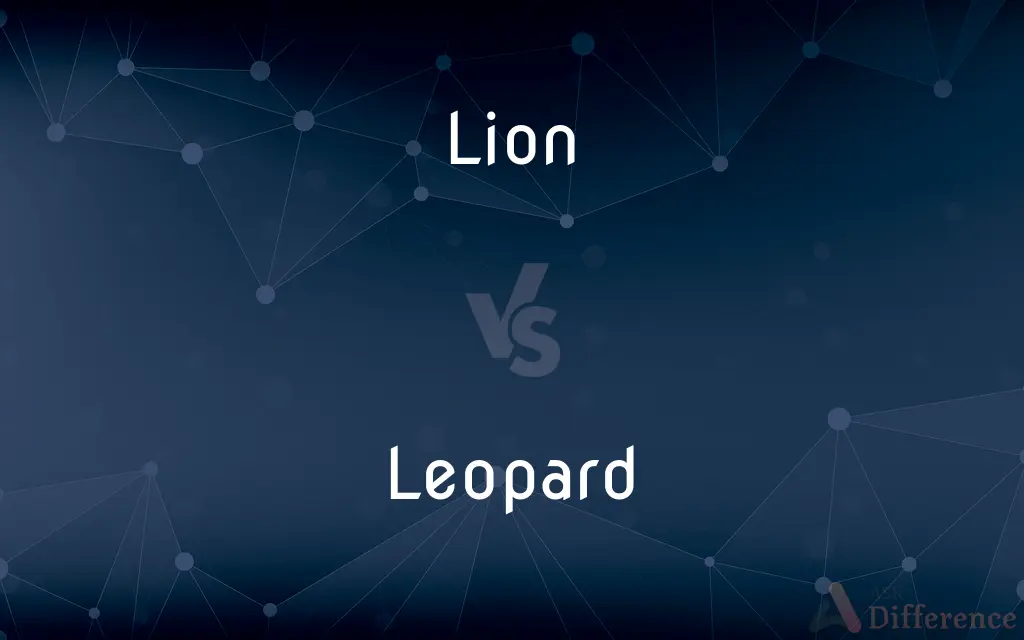Lion vs. Leopard — What's the Difference?
Edited by Tayyaba Rehman — By Fiza Rafique — Updated on April 26, 2024
Lions are social big cats known for their mane and pride-based structure, primarily found in Africa; leopards are solitary, highly adaptive felines with distinct rosette-patterned fur, inhabiting diverse habitats globally.

Difference Between Lion and Leopard
Table of Contents
ADVERTISEMENT
Key Differences
Lions are known for their distinctive physical characteristics, such as a large mane on the males and a body structure built for strength rather than stealth. This contrasts with leopards, which are smaller, more agile, and recognizable by their rosette-patterned coat which helps them blend into various habitats, facilitating their solitary hunting style.
While lions typically live in groups known as prides, consisting of related females, their offspring, and a small number of adult males, leopards lead a predominantly solitary life, only coming together for mating and occasionally sharing a kill. This social difference underscores their distinct approaches to survival and reproduction in the wild.
In terms of habitat, lions are mostly found in the grasslands and savannas of Sub-Saharan Africa, although a small population also exists in India. In contrast, leopards have a much wider geographic distribution, found in sub-Saharan Africa, parts of Asia, and Siberia, adapting to a variety of environments from rainforests to mountainous terrains.
Lions' hunting tactics are coordinated, utilizing the strength of the pride to take down large prey such as wildebeests and zebras. Leopards, on the other hand, utilize their stealth and agility to hunt a broader range of prey, from birds and small mammals to medium-sized antelopes, often hauling their food into trees to avoid scavengers.
Both lions and leopards face significant threats from habitat loss and human-wildlife conflict, but their conservation statuses differ. Lions are classified as vulnerable due to their declining population and habitat fragmentation, whereas leopards, though more widespread, face localized threats that also put them at risk of becoming endangered.
ADVERTISEMENT
Comparison Chart
Social Structure
Social, live in prides
Solitary, except in mating or maternal pairs
Physical Appearance
Larger, males have manes
Smaller, rosette-patterned coat
Habitat
Primarily grasslands and savannas of Africa
Diverse, including forests, mountains, savannas
Hunting Strategy
Cooperative, targets large herbivores
Solitary, diverse prey range, uses stealth
Conservation Status
Vulnerable
Varies, generally considered near threatened
Compare with Definitions
Lion
Lives in groups called prides, enhancing their ability to hunt large prey.
A pride of lions works together to hunt and protect their territory.
Leopard
A versatile feline species, Panthera pardus, known for its rosette-patterned coat.
Leopards are exceptional climbers, often dragging their prey up trees.
Lion
Males are distinguished by their mane, which signifies health and vitality.
The darker and fuller the mane, the more attractive the male lion is to females.
Leopard
Conservation status varies, with several subspecies critically endangered.
Efforts to protect habitat are crucial for the survival of leopard populations.
Lion
Vulnerable due to habitat loss and conflicts with humans.
Conservation efforts are crucial to prevent further decline of lion populations.
Leopard
Prefers a solitary lifestyle, with territories marked by scent.
Leopards are often elusive, avoiding contact with humans and other leopards.
Lion
Found mainly in Africa but also a small population in the Gir Forest of India.
African lions are often seen in nature documentaries.
Leopard
Their diet is varied, including insects, birds, and large mammals.
Leopards adjust their hunting techniques based on the available prey.
Lion
The lion (Panthera leo) is a large felid of the genus Panthera native mainly to Africa. It has a muscular, deep-chested body, short, rounded head, round ears, and a hairy tuft at the end of its tail.
Leopard
Highly adaptable, inhabits various environments across Africa and Asia.
The Amur leopard is adapted to the cold climates of the Russian Far East.
Lion
A large carnivorous feline mammal (Panthera leo) of Africa and northwest India, having a short tawny coat, a tufted tail, and, in the male, a heavy mane around the neck and shoulders.
Leopard
The leopard (Panthera pardus) is one of the five extant species in the genus Panthera, a member of the cat family, Felidae. It occurs in a wide range in sub-Saharan Africa, in some parts of Western and Central Asia, Southern Russia, and on the Indian subcontinent to Southeast and East Asia.
Lion
A mountain lion.
Leopard
A large wild cat (Panthera pardus) of Africa and southern Asia, having either tawny fur with dark rosettelike markings or black fur.
Lion
A very brave person.
Leopard
Any of several similar felines, such as the cheetah or the snow leopard.
Lion
A person regarded as fierce or savage.
Leopard
(Heraldry) A lion in side view, having one forepaw raised and the head facing the observer.
Lion
A noted person; a celebrity
A literary lion.
Leopard
Panthera pardus, a large wild cat with a spotted coat native to Africa and Asia, especially the male of the species (in contrast to leopardess).
Lion
Lion See Leo.
Leopard
(inexact) A similar-looking, large wild cat named after the leopard.
Lion
A big cat, Panthera leo, native to Africa, India and formerly much of Europe.
Tigers and lions share a common ancestor from a few million years ago.
Leopard
The clouded leopard (Neofelis nebulosa), a large wild cat native to Asia.
Lion
(in particular) A male lion, as opposed to a lioness.
Leopard
The snow leopard (Panthera uncia), a large wild cat native to Asia.
Lion
(by extension) Any of various extant and extinct big cats, especially the mountain lion.
Leopard
(heraldry) A lion passant guardant.
Lion
A Chinese foo dog.
Leopard
Any of various nymphalid butterflies of the genus Phalanta, having black markings on an orange base.
Lion
An individual who shows strength and courage, attributes associated with the lion.
Leopard
A large, savage, carnivorous mammal (Felis leopardus). It is of a yellow or fawn color, with rings or roselike clusters of black spots along the back and sides. It is found in Southern Asia and Africa. By some the panther (Felis pardus) is regarded as a variety of leopard.
Lion
A famous person regarded with interest and curiosity.
Leopard
The pelt of a leopard
Lion
A light brown color that resembles the fur of a lion. en
Leopard
Large feline of African and Asian forests usually having a tawny coat with black spots
Lion
(historical) An old Scottish coin, with a lion on the obverse, worth 74 shillings.
Lion
Of the light brown color that resembles the fur of a lion.
Lion
A large carnivorous feline mammal (Panthera leo, formerly Felis leo), found in Southern Asia and in most parts of Africa, distinct varieties occurring in the different countries. The adult male, in most varieties, has a thick mane of long shaggy hair that adds to his apparent size, which is less than that of the largest tigers. The length, however, is sometimes eleven feet to the base of the tail. The color is a tawny yellow or yellowish brown; the mane is darker, and the terminal tuft of the tail is black. In one variety, called the maneless lion, the male has only a slight mane.
Lion
A sign and a constellation; Leo.
Lion
An object of interest and curiosity, especially a person who is so regarded; as, he was quite a lion in London at that time.
Such society was far more enjoyable than that of Edinburgh, for here he was not a lion, but a man.
Lion
Large gregarious predatory feline of Africa and India having a tawny coat with a shaggy mane in the male
Lion
A celebrity who is lionized (much sought after)
Lion
(astrology) a person who is born while the sun is in Leo
Lion
The fifth sign of the zodiac; the sun is in this sign from about July 23 to August 22
Lion
A large feline species, Panthera leo, known for its social structure and mane on males.
The lion's roar can be heard up to 8 km away.
Common Curiosities
What adaptations help leopards survive in diverse environments?
Leopards have adaptable hunting skills and an ability to climb, which helps them thrive in various habitats from rainforests to mountainous regions.
Why are male lions the only cat species with a mane?
The mane of a male lion is thought to protect its neck during fights and serves as a signal of health status to potential mates.
How do leopards avoid competition with lions?
Leopards tend to hunt different prey and often keep a nocturnal schedule to avoid direct competition with lions.
Are leopards or lions at greater risk of extinction?
Both face significant threats, but lions have a more critical conservation status due to their more limited distribution and larger size, which makes them more vulnerable.
What is the main difference between a lion and a leopard?
The main difference lies in their social structure: lions are social and live in prides, while leopards are solitary.
How does the presence of humans affect lions and leopards?
Human expansion into wildlife areas leads to habitat fragmentation and conflicts, negatively impacting both species.
What are the conservation challenges facing lions?
Lions face challenges such as habitat loss, human-wildlife conflict, and decreasing prey bases due to overhunting.
Why do leopards sometimes drag their prey into trees?
Dragging prey into trees allows leopards to keep it away from other predators and scavengers, securing their food.
Can lions and leopards be found in the same habitat?
In some areas like the African savannas, both lions and leopards coexist, although they occupy different ecological niches.
How do lions and leopards impact the ecosystem?
As top predators, both play crucial roles in controlling the population of other wildlife, maintaining the health of their ecosystems.
What strategies are effective in conserving lions and leopards?
Effective conservation strategies include habitat preservation, anti-poaching efforts, and community-based conservation programs that involve local populations.
What is the significance of mane color and size in lions?
A fuller and darker mane is often associated with a healthier and more genetically fit lion, which is more attractive to females.
What role do prides play in lion social behavior?
Prides facilitate cooperative hunting and cub-rearing, which increases survival rates in harsh environments.
How do lions and leopards communicate?
Lions communicate through vocalizations, scent marking, and visual displays; leopards rely more on scent marking and subtle vocalizations due to their solitary nature.
Can leopards change their habitat preferences based on available resources?
Yes, leopards are highly adaptable and can modify their habitat use based on prey availability and presence of competitors like lions.
Share Your Discovery

Previous Comparison
Industry vs. Commerce
Next Comparison
Cleaning vs. CleansingAuthor Spotlight
Written by
Fiza RafiqueFiza Rafique is a skilled content writer at AskDifference.com, where she meticulously refines and enhances written pieces. Drawing from her vast editorial expertise, Fiza ensures clarity, accuracy, and precision in every article. Passionate about language, she continually seeks to elevate the quality of content for readers worldwide.
Edited by
Tayyaba RehmanTayyaba Rehman is a distinguished writer, currently serving as a primary contributor to askdifference.com. As a researcher in semantics and etymology, Tayyaba's passion for the complexity of languages and their distinctions has found a perfect home on the platform. Tayyaba delves into the intricacies of language, distinguishing between commonly confused words and phrases, thereby providing clarity for readers worldwide.















































